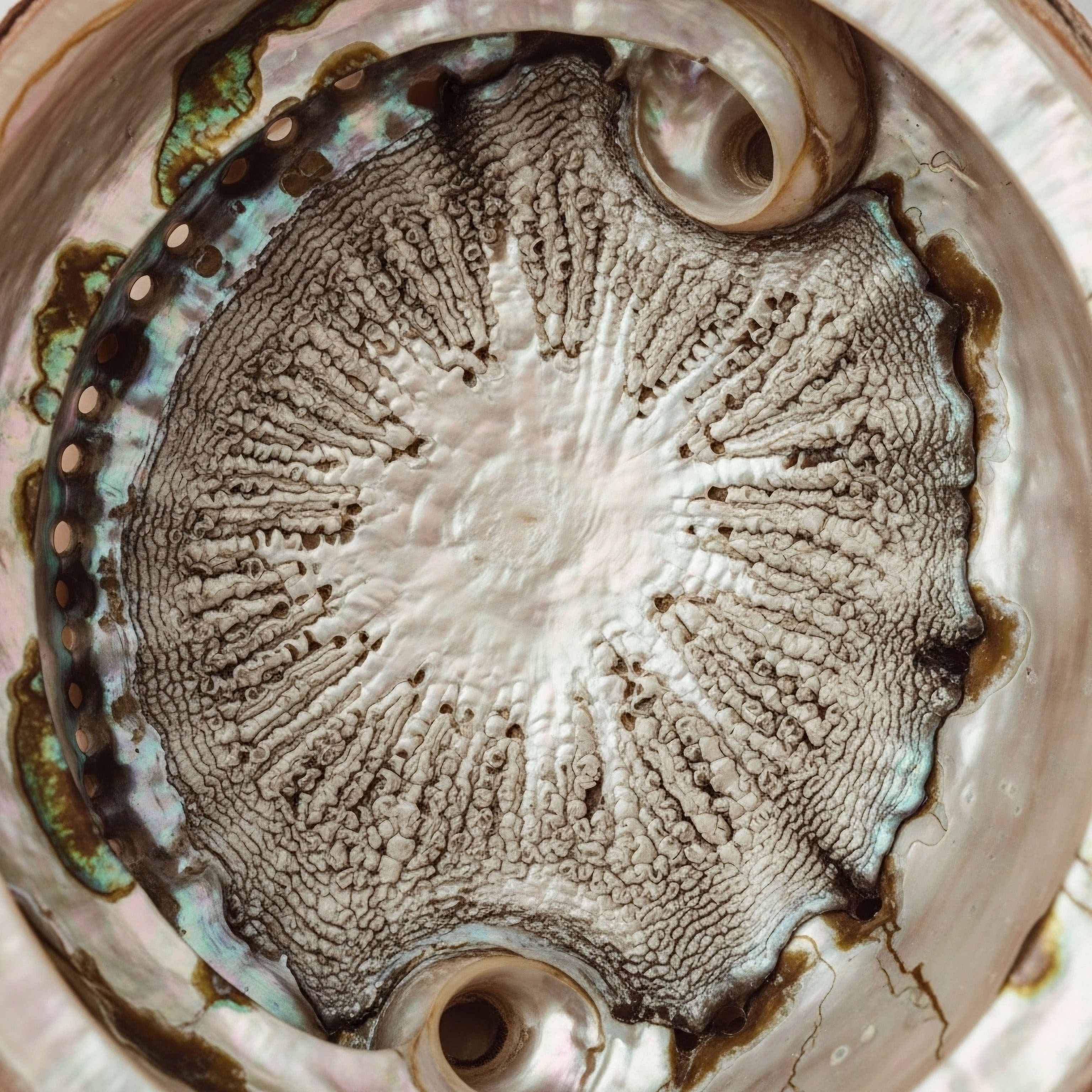

Fundamentals
Have you ever felt a subtle shift in your body, a creeping sense of diminished vitality, or perhaps a less resilient cardiovascular system than you once experienced? Many individuals describe a feeling of being “off,” a vague sense that their internal equilibrium has been disrupted.
This sensation often manifests as unexplained fatigue, changes in body composition, or a general decline in well-being, sometimes even before overt symptoms of cardiovascular concern arise. It is a deeply personal experience, one that can leave you searching for answers, wondering if these changes are simply an inevitable part of aging or if something more fundamental is at play within your biological systems.
Your body possesses an intricate network of chemical messengers, known as hormones, which orchestrate nearly every physiological process. Among these, the gonadal hormones ∞ primarily testosterone and estrogens ∞ play a central role far beyond their well-known reproductive functions.
These powerful signaling molecules act as conductors in the grand symphony of your internal environment, influencing everything from cellular energy production to the integrity of your blood vessels. Understanding their influence on cardiovascular health requires looking beyond simple definitions and recognizing their pervasive systemic impact.
Gonadal hormones, such as testosterone and estrogens, are essential chemical messengers that profoundly influence cardiovascular well-being.

The Endocrine System’s Orchestration
The endocrine system operates as a sophisticated communication network, with glands releasing hormones directly into the bloodstream. These hormones then travel to target cells throughout the body, where they bind to specific receptors, initiating a cascade of biological responses. The gonads, specifically the testes in biological males and the ovaries in biological females, are primary producers of sex steroids.
These steroids, however, do not operate in isolation; they are part of a larger, interconnected system that includes the hypothalamus and pituitary gland, forming what is known as the Hypothalamic-Pituitary-Gonadal (HPG) axis.
This axis functions as a delicate feedback loop, ensuring that hormone levels remain within a healthy physiological range. The hypothalamus releases gonadotropin-releasing hormone (GnRH), which signals the pituitary gland to release luteinizing hormone (LH) and follicle-stimulating hormone (FSH). These gonadotropins then stimulate the gonads to produce their respective hormones. Disruptions at any point in this axis can lead to imbalances that reverberate throughout the body, affecting various systems, including the cardiovascular system.

Gonadal Hormones and Vascular Integrity
The influence of gonadal hormones on cardiovascular health extends to the very structure and function of your blood vessels. These hormones directly impact the endothelial cells lining your arteries, which are critical for maintaining vascular tone and preventing plaque formation. Healthy endothelial function allows blood vessels to dilate and constrict appropriately, ensuring optimal blood flow and pressure regulation.
Testosterone, for instance, has been shown to influence the relaxation of blood vessels, potentially contributing to healthy blood pressure regulation. Estrogens, particularly estradiol, are recognized for their vasodilatory effects and their role in maintaining endothelial integrity, which can protect against arterial stiffness and atherosclerosis. When these hormonal influences diminish, the cardiovascular system can become more vulnerable to adverse changes.

Metabolic Interconnections
Beyond direct vascular effects, gonadal hormones are deeply intertwined with metabolic function, which in turn has significant implications for cardiovascular health. Metabolic dysregulation, characterized by conditions such as insulin resistance, dyslipidemia, and abdominal adiposity, represents a major risk factor for heart disease. Gonadal hormones play a regulatory role in glucose metabolism, lipid profiles, and fat distribution.
For example, optimal testosterone levels in men are associated with healthier insulin sensitivity and more favorable lipid profiles, including higher levels of high-density lipoprotein (HDL) cholesterol and lower levels of low-density lipoprotein (LDL) cholesterol and triglycerides. Similarly, estrogens in women contribute to a healthier metabolic state, influencing fat storage patterns and glucose utilization. A decline in these hormone levels can predispose individuals to metabolic shifts that increase cardiovascular risk.


Intermediate
As we move beyond the foundational understanding, it becomes clear that the relationship between gonadal hormone levels and cardiovascular health is not merely correlational; it is mechanistic. When individuals experience symptoms related to hormonal changes, such as persistent fatigue, reduced muscle mass, increased body fat, or diminished libido, these are often signals from a system seeking recalibration. Addressing these concerns requires a clinically informed approach, often involving targeted hormonal optimization protocols designed to restore physiological balance and support cardiovascular resilience.
The goal of these interventions extends beyond symptom management; it aims to restore the body’s innate intelligence, allowing its systems to operate with greater efficiency and vitality. This involves a precise understanding of how specific therapeutic agents interact with the body’s complex biochemical pathways.
Targeted hormonal optimization protocols aim to restore physiological balance, supporting cardiovascular resilience through precise biochemical recalibration.

Testosterone Replacement Therapy for Men
For men experiencing symptoms of low testosterone, often referred to as andropause, Testosterone Replacement Therapy (TRT) can be a significant component of a personalized wellness protocol. The decline in endogenous testosterone production can contribute to adverse cardiovascular changes, including increased visceral fat, insulin resistance, and endothelial dysfunction. TRT aims to restore testosterone levels to a healthy physiological range, thereby mitigating these risks.
A standard protocol often involves weekly intramuscular injections of Testosterone Cypionate (200mg/ml). This method provides a steady release of the hormone, avoiding the peaks and troughs associated with less frequent dosing. The administration of exogenous testosterone, however, can suppress the body’s natural production of testosterone by inhibiting the HPG axis. To counteract this, specific adjunct medications are often included:
- Gonadorelin ∞ Administered as 2x/week subcutaneous injections, Gonadorelin acts as a GnRH analog, stimulating the pituitary to release LH and FSH. This helps to maintain testicular function and natural testosterone production, preserving fertility.
- Anastrozole ∞ This oral tablet, typically taken 2x/week, is an aromatase inhibitor. It blocks the conversion of testosterone into estrogen, which can be important for managing potential side effects such as gynecomastia and water retention, and for maintaining a healthy testosterone-to-estrogen ratio, which is also relevant for cardiovascular health.
- Enclomiphene ∞ In some cases, Enclomiphene may be included. This selective estrogen receptor modulator (SERM) stimulates LH and FSH release from the pituitary, further supporting endogenous testosterone production, particularly for men concerned with fertility preservation.

Testosterone Replacement Therapy for Women
Hormonal balance is equally critical for women, particularly during pre-menopausal, peri-menopausal, and post-menopausal phases, where declining gonadal hormone levels can impact cardiovascular health. Women may experience symptoms such as irregular cycles, mood changes, hot flashes, and reduced libido, which can be linked to shifts in estrogen and testosterone.
Protocols for women are carefully tailored to their unique physiology and menopausal status. A common approach involves low-dose testosterone administration:
- Testosterone Cypionate ∞ Typically 10 ∞ 20 units (0.1 ∞ 0.2ml) weekly via subcutaneous injection. This low dose aims to restore physiological testosterone levels, which can support libido, energy, and body composition, all of which indirectly influence cardiovascular markers.
- Progesterone ∞ Prescribed based on menopausal status, progesterone plays a vital role in female hormonal balance, particularly in protecting the uterine lining and supporting mood and sleep. Its role in cardiovascular health is also being increasingly recognized, especially in conjunction with estrogen.
- Pellet Therapy ∞ Long-acting testosterone pellets offer a convenient alternative, providing a sustained release of the hormone over several months. When appropriate, Anastrozole may also be used in women to manage estrogen levels, particularly in cases where testosterone conversion to estrogen is a concern.

Post-TRT or Fertility-Stimulating Protocols for Men
For men who have discontinued TRT or are actively trying to conceive, a specific protocol is designed to restart and optimize natural testosterone production and fertility. This involves a combination of agents that stimulate the HPG axis and manage estrogen levels:
- Gonadorelin ∞ Continues to stimulate LH and FSH release, encouraging testicular function.
- Tamoxifen ∞ A SERM that blocks estrogen receptors in the pituitary, leading to increased LH and FSH secretion and subsequent testosterone production.
- Clomid (Clomiphene Citrate) ∞ Another SERM, similar to Tamoxifen, that stimulates gonadotropin release, thereby boosting endogenous testosterone.
- Anastrozole ∞ Optionally included to manage estrogen levels, which can rise as testosterone production increases, ensuring a favorable hormonal environment for fertility.

Growth Hormone Peptide Therapy and Cardiovascular Support
Beyond gonadal hormones, other biochemical recalibration strategies, such as growth hormone peptide therapy, can indirectly support cardiovascular health by influencing metabolic function, body composition, and cellular repair. These peptides stimulate the body’s natural production of growth hormone, avoiding the supraphysiological levels associated with exogenous growth hormone administration.
Active adults and athletes often seek these therapies for anti-aging benefits, muscle gain, fat loss, and sleep improvement, all of which contribute to overall metabolic and cardiovascular well-being.
| Peptide Name | Primary Mechanism of Action | Potential Cardiovascular Relevance |
|---|---|---|
| Sermorelin | Stimulates natural growth hormone release from the pituitary. | Improved body composition, reduced visceral fat, enhanced lipid profiles. |
| Ipamorelin / CJC-1295 | Potent growth hormone secretagogues, increasing GH pulse amplitude. | Support for lean muscle mass, fat reduction, metabolic health. |
| Tesamorelin | Specific for reducing visceral adipose tissue (VAT). | Directly targets a key cardiovascular risk factor (VAT). |
| Hexarelin | Growth hormone secretagogue with potential for cardiac benefits. | May support cardiac function and tissue repair. |
| MK-677 (Ibutamoren) | Oral growth hormone secretagogue, increases GH and IGF-1. | Supports muscle mass, bone density, and metabolic parameters. |

Other Targeted Peptides for Systemic Health
The precision of peptide therapy extends to other areas that indirectly influence cardiovascular health by improving systemic function and reducing inflammation.
- PT-141 (Bremelanotide) ∞ Primarily used for sexual health, PT-141 acts on melanocortin receptors in the brain to improve sexual desire and arousal. Healthy sexual function is often a marker of overall vascular health and well-being.
- Pentadeca Arginate (PDA) ∞ This peptide is being explored for its roles in tissue repair, healing, and inflammation modulation. Chronic inflammation is a significant contributor to cardiovascular disease progression, and agents that can mitigate inflammatory processes offer systemic benefits.

How Do Hormonal Protocols Influence Vascular Reactivity?
The mechanisms by which these hormonal and peptide protocols influence cardiovascular health are complex, involving direct effects on vascular cells and indirect effects through metabolic improvements. For instance, optimizing testosterone levels in men can lead to improved endothelial function, allowing blood vessels to dilate more effectively in response to physiological demands.
This improved vascular reactivity is a hallmark of a healthy cardiovascular system. Similarly, in women, maintaining appropriate estrogen levels supports nitric oxide production, a potent vasodilator, which helps keep arteries supple and responsive. These targeted interventions aim to restore the body’s natural capacity for self-regulation, thereby enhancing cardiovascular resilience.


Academic
The deep exploration of how gonadal hormone levels influence cardiovascular health requires a rigorous, systems-biology perspective, moving beyond isolated observations to understand the intricate interplay of biological axes, metabolic pathways, and cellular signaling.
This level of analysis reveals the profound interconnectedness of the endocrine system with the cardiovascular system, demonstrating that hormonal balance is not merely a matter of well-being, but a fundamental determinant of long-term cardiovascular integrity. We must consider the molecular mechanisms and the broader physiological consequences of hormonal fluctuations.
Understanding the influence of gonadal hormones on cardiovascular health necessitates a systems-biology perspective, analyzing intricate biological axes and cellular signaling.

Steroidogenesis and Receptor Dynamics
Gonadal hormones, such as testosterone and estradiol, are synthesized from cholesterol through a series of enzymatic reactions, a process known as steroidogenesis. These hormones exert their effects by binding to specific intracellular receptors ∞ androgen receptors (AR) for testosterone and estrogen receptors (ERα and ERβ) for estrogens. These hormone-receptor complexes then translocate to the nucleus, where they act as transcription factors, regulating the expression of genes involved in various physiological processes, including those critical for cardiovascular function.
The distribution and density of these receptors vary across different tissues, including the heart and vasculature. For example, ARs and ERs are present in endothelial cells, vascular smooth muscle cells, and cardiomyocytes. Their presence indicates a direct role for gonadal hormones in regulating vascular tone, endothelial integrity, and myocardial function. The precise balance between AR and ER activation within these tissues is a significant determinant of cardiovascular health outcomes.

The HPG Axis and Cardiovascular Homeostasis
The Hypothalamic-Pituitary-Gonadal (HPG) axis is the central regulatory pathway for gonadal hormone production. Dysregulation within this axis, whether due to aging, chronic stress, or underlying medical conditions, can lead to hypogonadism in men and women. This state of hormonal deficiency has direct implications for cardiovascular homeostasis.
In men, low testosterone is associated with an increased prevalence of metabolic syndrome components, including central obesity, insulin resistance, dyslipidemia, and hypertension. Longitudinal studies indicate that men with lower testosterone levels have a higher risk of developing cardiovascular disease and experiencing adverse cardiovascular events. The mechanisms involve testosterone’s influence on nitric oxide synthase (NOS) activity, which affects endothelial function, and its role in modulating inflammatory cytokines and adipokines.
For women, the decline in estrogen during perimenopause and postmenopause is linked to an accelerated risk of cardiovascular disease. Estrogens are known to promote endothelial-dependent vasodilation through increased nitric oxide bioavailability and to exert anti-inflammatory and antioxidant effects within the vasculature.
The loss of these protective effects contributes to increased arterial stiffness, impaired lipid profiles, and a pro-atherogenic environment. The timing and duration of estrogen exposure appear to be critical, with the “window of opportunity” hypothesis suggesting that early intervention may offer greater cardiovascular benefits.

Inflammation, Oxidative Stress, and Hormonal Balance
Chronic low-grade inflammation and oxidative stress are recognized as fundamental drivers of atherosclerosis and cardiovascular disease progression. Gonadal hormones play a significant role in modulating these processes. Testosterone, at physiological levels, can exert anti-inflammatory effects by suppressing pro-inflammatory cytokines such as TNF-α and IL-6. Conversely, hypogonadism in men is often associated with elevated markers of systemic inflammation.
Estrogens are potent antioxidants and anti-inflammatory agents. They can reduce the production of reactive oxygen species (ROS) and inhibit the expression of adhesion molecules on endothelial cells, thereby reducing leukocyte recruitment and plaque formation. The protective effects of estrogens on the vasculature are partly mediated by their ability to upregulate antioxidant enzymes and suppress inflammatory signaling pathways.
A disruption in the delicate balance of these hormones can therefore tip the scales towards a pro-inflammatory and pro-oxidative state, accelerating cardiovascular pathology.

How Do Gonadal Hormones Impact Lipid Metabolism and Glucose Homeostasis?
The influence of gonadal hormones on lipid metabolism and glucose homeostasis is a critical aspect of their cardiovascular impact. Testosterone influences hepatic lipid synthesis and lipoprotein lipase activity, affecting the circulating levels of cholesterol and triglycerides. Optimal testosterone levels are generally associated with a more favorable lipid profile, characterized by higher HDL cholesterol and lower LDL cholesterol and triglycerides. Conversely, hypogonadism can lead to dyslipidemia, a significant cardiovascular risk factor.
Estrogens also play a central role in lipid regulation, typically promoting higher HDL and lower LDL levels in premenopausal women. They influence the expression of genes involved in lipid transport and metabolism. Regarding glucose homeostasis, both testosterone and estrogens can enhance insulin sensitivity.
Testosterone can improve glucose uptake in muscle and adipose tissue, while estrogens influence pancreatic beta-cell function and insulin signaling pathways. Hormonal imbalances can therefore contribute to insulin resistance and type 2 diabetes, conditions that profoundly increase cardiovascular risk.
| Risk Factor | Testosterone Influence (Men) | Estrogen Influence (Women) |
|---|---|---|
| Endothelial Function | Promotes vasodilation, improves nitric oxide bioavailability. | Enhances vasodilation, maintains endothelial integrity, increases nitric oxide. |
| Lipid Profile | Generally improves HDL, lowers LDL and triglycerides. | Increases HDL, lowers LDL, influences hepatic lipid metabolism. |
| Insulin Sensitivity | Enhances glucose uptake and insulin signaling. | Improves pancreatic beta-cell function and insulin sensitivity. |
| Inflammation | Anti-inflammatory effects, suppresses pro-inflammatory cytokines. | Anti-inflammatory, antioxidant, reduces adhesion molecules. |
| Body Composition | Reduces visceral fat, increases lean muscle mass. | Influences fat distribution, generally less central adiposity. |

The Role of Growth Hormone and Peptides in Cardiovascular Remodeling
While gonadal hormones are primary, the broader endocrine landscape, including growth hormone (GH) and its associated peptides, also influences cardiovascular health, particularly in the context of cellular repair and metabolic regulation. GH exerts its effects largely through Insulin-like Growth Factor 1 (IGF-1), which has widespread anabolic and metabolic actions.
GH deficiency is associated with adverse cardiovascular risk profiles, including increased visceral adiposity, dyslipidemia, and endothelial dysfunction. Growth hormone-releasing peptides (GHRPs) and growth hormone-releasing hormone (GHRH) analogs, such as Sermorelin and Ipamorelin/CJC-1295, stimulate the pulsatile release of endogenous GH.
This physiological approach aims to restore GH/IGF-1 axis function, which can lead to improvements in body composition, lipid profiles, and insulin sensitivity, thereby indirectly supporting cardiovascular health. Tesamorelin, a GHRH analog, has shown specific efficacy in reducing visceral adipose tissue (VAT) in individuals with HIV-associated lipodystrophy, highlighting its potential to target a significant cardiovascular risk factor. The systemic recalibration achieved through these peptides contributes to a more resilient metabolic and cardiovascular environment.

Can Gonadal Hormone Optimization Mitigate Age-Related Cardiovascular Decline?
The question of whether optimizing gonadal hormone levels can mitigate age-related cardiovascular decline is a subject of ongoing clinical investigation. As individuals age, a natural decline in gonadal hormone production occurs, often coinciding with an increased incidence of cardiovascular disease. The hypothesis is that restoring these hormones to more youthful, physiological levels could offer protective benefits.
Clinical trials and observational studies have explored this relationship, with varying results often dependent on the specific hormone, dosage, route of administration, and patient population. The complexity arises from the interplay of multiple factors, including pre-existing cardiovascular conditions, individual genetic predispositions, and lifestyle choices.
A personalized approach, guided by comprehensive laboratory assessments and clinical evaluation, is essential to determine the appropriate course of action, aiming to balance potential benefits with any associated risks. The objective is to support the body’s intrinsic capacity for repair and regulation, thereby promoting long-term cardiovascular vitality.

References
- Jones, R. E. & Lopez, K. H. (2014). Human Reproductive Biology (4th ed.). Academic Press.
- Boron, W. F. & Boulpaep, E. L. (2016). Medical Physiology (3rd ed.). Elsevier.
- Guyton, A. C. & Hall, J. E. (2020). Textbook of Medical Physiology (14th ed.). Elsevier.
- Rosen, C. J. & LeRoith, D. (2019). Endocrinology ∞ Adult and Pediatric (8th ed.). Elsevier.
- Mendelsohn, M. E. & Karas, R. H. (2005). The protective effects of estrogen on the cardiovascular system. The New England Journal of Medicine, 353(19), 2007-2019.
- Traish, A. M. & Saad, F. (2017). Testosterone and the cardiovascular system ∞ an update. Journal of Cardiovascular Pharmacology and Therapeutics, 22(5), 411-423.
- Rosano, G. M. Vitale, C. & Fini, M. (2017). Testosterone and cardiovascular disease ∞ an update. Journal of Endocrinological Investigation, 40(11), 1165-1172.
- Miller, K. K. & Grinspoon, S. K. (2016). Growth hormone and the cardiovascular system. Endocrine Reviews, 37(3), 265-282.
- Gottfried, S. (2013). The Hormone Reset Diet ∞ Heal Your Hormones and Lose Up to 15 Pounds in 21 Days. HarperOne.
- Hyman, M. (2015). The UltraMind Solution ∞ Fix Your Broken Brain by Healing Your Body First. Scribner.

Reflection
As you consider the intricate connections between your gonadal hormone levels and the health of your cardiovascular system, perhaps a deeper understanding of your own biological systems begins to take shape. This knowledge is not merely academic; it is a lens through which to view your personal health journey, recognizing that symptoms are often signals from a body seeking balance.
The insights shared here serve as a starting point, a foundation upon which to build a more personalized approach to your well-being.
Your path to reclaiming vitality and optimal function is unique, shaped by your individual physiology, lifestyle, and aspirations. Armed with a clearer picture of how hormones influence your heart and vessels, you are better equipped to engage in meaningful conversations about your health, advocating for protocols that align with your body’s specific needs. This understanding empowers you to move forward with purpose, seeking to recalibrate your internal systems for sustained health and resilience.



